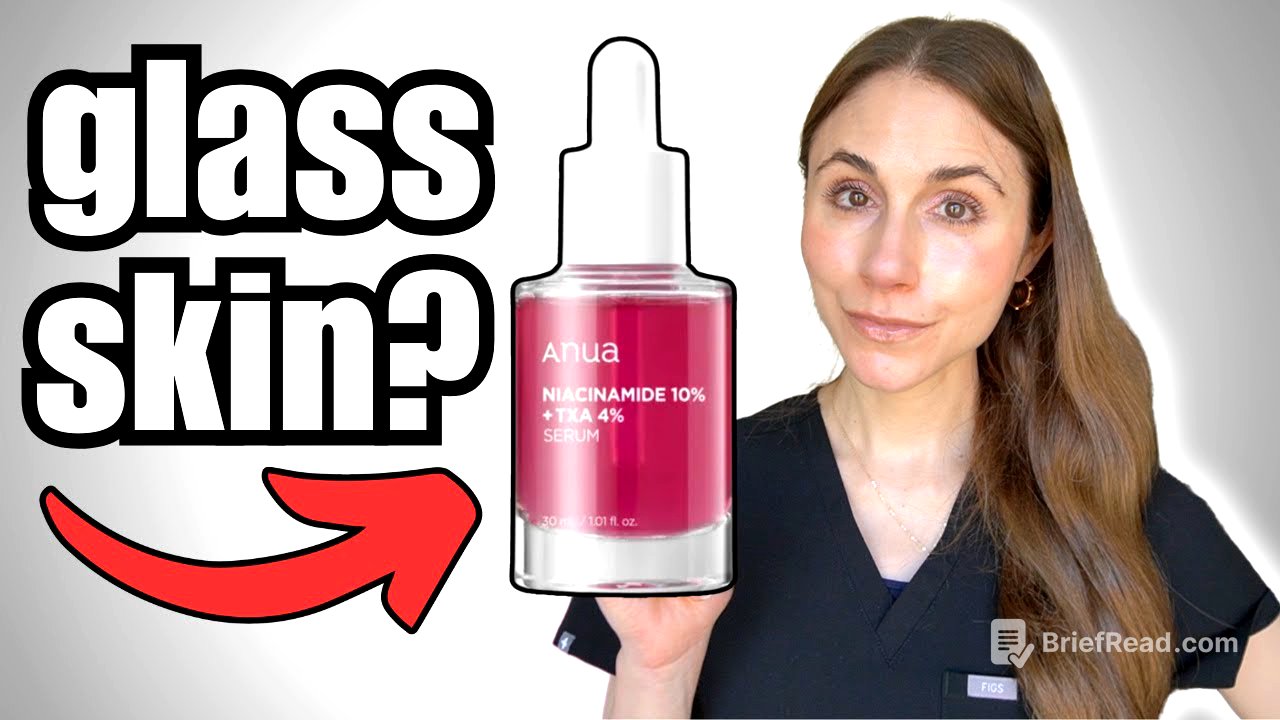TLDR;
This video is about the Anua 10% Niacinamide + 4% Tranexamic Acid Serum. Dr. Dray discusses the serum's ingredients, their potential benefits for skin concerns like hyperpigmentation, redness, and barrier function, and her personal experience using the product. Key takeaways include the potential of tranexamic acid for redness and hyperpigmentation, the importance of niacinamide for skin barrier and antioxidant benefits, and the overall soothing and brightening effect of the serum.
- Tranexamic acid and niacinamide can help with hyperpigmentation and redness.
- Polyglutamic acid is great for hydration and skin elasticity.
- The serum is good for layering and is generally well-tolerated.
Introduction to Anua Serum [0:00]
Dr. Dray is reviewing the Anua 10% Niacinamide + 4% Tranexamic Acid Serum, which she got in a Korean advent calendar. The serum claims to improve skin tone and clarity. It contains 10% niacinamide and 4% tranexamic acid in a 30ml bottle that costs $22.
Tranexamic Acid: Benefits and Research [0:24]
Tranexamic acid, usually taken orally for melasma, might also help when applied to the skin. Research suggests it can reduce facial redness, including rosacea and post-inflammatory erythema from acne. It may also reduce acne inflammation (papules and pustules) and hyperpigmentation by blocking pigment transfer in the skin. Tranexamic acid might also slow down abnormal blood vessel growth (angiogenesis) and improve skin barrier function by inhibiting PAR-2. Clinical studies show it's generally well-tolerated, with occasional redness or peeling that can be managed with moisturizer.
Niacinamide: Benefits and Concentration [3:58]
Niacinamide, a B vitamin, is an antioxidant and anti-inflammatory that supports the skin barrier. This helps reduce irritation, redness, and penetration of irritants, which is beneficial for acne-prone skin. Niacinamide also helps with redness and dark spots by interfering with pigment transfer. It can defend against oxidative stress, making it useful in anti-aging skincare. The serum contains 10% niacinamide, which is a higher concentration than the 2-5% used in clinical studies. While high percentages aren't necessarily more effective and can be irritating, it's fine if your skin tolerates it well.
Additional Ingredients: Polyglutamic Acid, Alpha Arbutin, and B12 [5:51]
The serum includes polyglutamic acid, which hydrates and improves moisture retention, creating a hydrating veil on the skin and limiting hyaluronic acid breakdown. Dr. Dray finds it visibly improves skin plumpness, firmness, elasticity, and softness. It also contains 2% alpha arbutin, which inhibits tyrosinase, the enzyme responsible for pigment production. The combination of ingredients addressing hyperpigmentation in different ways makes the product potentially more effective. The pink color of the serum comes from cyanocobalamin (vitamin B12), which has shown promise for helping with atopic dermatitis symptoms.
Botanical Extracts, Olive Oil, and Other Ingredients [7:15]
The serum contains botanical extracts with anti-inflammatory and antioxidant properties, such as compounds from Centella and Artemisia. While fragrance-free, those with fragrance allergies should be aware that botanical extracts may contain cross-reacting compounds. It also contains olive oil, which, when used alone, can worsen water loss but is fine in formulated products. Olive oil has anti-inflammatory and antioxidant properties and acts as an emollient. Other hydrating ingredients include hyaluronic acid and peach flower extract.
How to Use and Layer the Serum [9:54]
The serum can be used one to two times a day as the first step after cleansing. A couple of drops is enough due to its good spreadability. Its thin texture makes it good for layering with other products, like sunscreen in the morning. Sunscreen is essential for fading redness or dark spots. The serum absorbs quickly and isn't oily, making it compatible with most sunscreens and moisturizers. While it contains hydrating ingredients, it may not be moisturizing enough on its own, so a moisturizer might still be needed.
Overall Experience and Final Thoughts [11:45]
Dr. Dray has tolerated the serum well and finds it soothing. She feels her skin tone looks brighter and more even with consistent use. It seems to help with irritation from shaving. Overall, she thinks it's a good serum if you're not irritated by niacinamide. Results will vary depending on the nature of your redness and hyperpigmentation. The serum is similar to the e.l.f. serum she reviewed, which also contains tranexamic acid and niacinamide but includes exfoliating ingredients.









